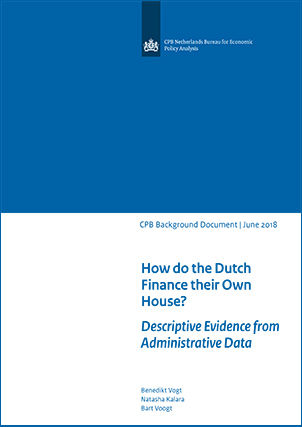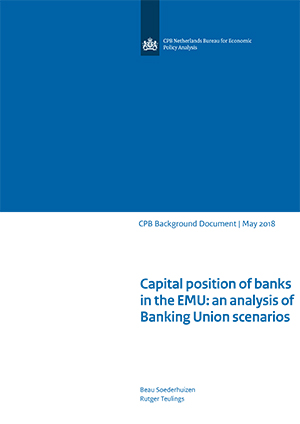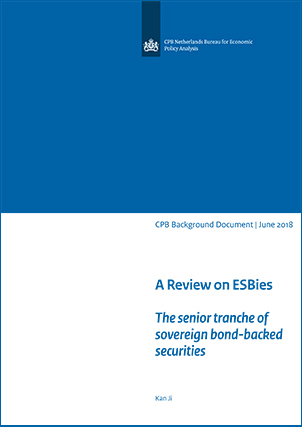Towards an EMU banking union: three scenarios
Downloads
There is currently much discussion about the future of the Economic and Monetary Union of the European Union (EMU). This month (June 2018), the European Council plans to discuss future reforms regarding the banking union. The European Commission has drafted a roadmap containing proposals for a more comprehensive EMU, including rapid completion of the banking union. A group of eight, mostly Nordic, countries is in favour of the banking union ultimately being completed, but believes that the first priority should be risk reduction.
This publication discusses the need for an EMU banking union and describes three possible transition scenarios. The European Commission’s roadmap also contains proposals for other types of EMU reform (e.g. a budgetary union, capital market union or the introduction of a European Monetary Fund), but this publication only addresses the banking union. In addition to this report, the CPB will also publish a background document, titled ‘Capital position of banks in the EMU: an analysis of Banking Union scenarios’, in which calculations are presented that show the consequences of various elements of the banking union, for the largest banks within the EMU.
In het eerste kwartaal van 2018 lagen huizenprijzen 9% hoger dan in hetzelfde kwartaal één jaar eerder. In de Randstad – in het bijzonder in de vier grote steden – zijn huizenprijzen nog sterker gestegen. Landelijk is het nominale prijsniveau uit 2008 weer bereikt. De sterke stijging van de prijzen roept bij sommigen vragen op over oververhitting en bubbelvorming. De analyses in dit achtergronddocument laten zien dat er in sommige regio’s sprake is van oververhitting op de markt doordat het aanbod op korte termijn de vraag niet kan bijbenen. Deze oververhitting – samen met de jubelstemming die op dit moment op de woningmarkt heerst - is op dit moment echter nog niet problematisch. Voor zover we daar iets over kunnen zeggen, lijkt van een bubbel nog geen sprake te zijn. Dat zegt overigens weinig over de toekomst; toekomstige bubbelvorming kan niet worden uitgesloten.
Authors
We first describe the financing patterns that actually occurred. In a second step we investigate the potential of Dutch households to reduce their mortgage lending. We do so by ‘simulating’ the financing patterns that could occur if homeowners use all of their financial assets to pay for their own house.
First time buyers (‘starters’) make more use of other forms of equity -such as savings and gifts- over time. Their capacity to decrease their mortgage debt and use other forms of financing also increases in the period from 2006- 2014. Second time buyers (‘doorstromers’) make use of the positive home equity of their previous house and also increase the use of other forms of equity over time. When we compare single and cohabiting households, we observe that single households seem to have lower mortgage debt on average and also more potential to reduce the mortgage debt at the time of purchase.
Our results have to be taken with a grain of salt: First, they can be driven by cheaper house prices and a tax reduction on gifts (‘schenkingsvrijstelling’). Unfortunately our data does not allow us to pinpoint the exact source. If gifts are the driving force in lowering the actual mortgage, we overestimate the potential of households to lower their mortgage. Secondly, our data show substantial heterogeneity: further studies should focus on subgroups to validate to what extent our figures are representative for them.
Authors
We consider shocks in which either one or both write-offs are required. We also investigate regulatory changes on the capital position of banks that are proposed for the deepening of the Banking Union.
We investigate both the write-offs and the regulatory changes by looking at the loss of capital (or addition to risk weighted assets) both at a country-level and at the individual bank level. We also consider the simultaneous implementation of combinations of these write-offs and regulatory changes. The impact on the capital position of a bank is measured by the change in the bank’s core capital (CET1). This is the most narrow definition of capital used by the Bank for International Settlements under Basel III, and is commonly used to express the impact of stress tests.
For the analysis we use data on the 92 biggest banks in the Eurozone and other EU countries. We obtain data on the balance sheet positions of these banks from the European Banking Authority’s (EBA) transparency exercise. The EBA data collection includes all large banks that are under direct supervision of the Single Supervisory Mechanism (SSM). Note that small banks are not included in this dataset. For the current analysis we use the data from June 2017. In the analyses we only consider the direct (or first-round) effects on the capital position of banks. Due to the nature of the data, we are not able to include potential second-round effects, induced by changes to the state of the economy or for example via inter-bank loans or shares.
The results we obtain can be summarized as follows. First, we simulate the effects of a write-off of 20% of Italian debt in case of a restructuring. Our findings show that predominately banks in Italy are hardest hit, while the impact on banks outside Italy is only minor. We also study a 20% write-off of the debt of all GIIPS countries. In this example it is primarily banks in Portugal, Italy and Spain which see a substantial drop in their core capital ratio. These two findings show that the national sovereign-bank nexus may still pose a threat, but that the risk of direct contagion to banks in other countries is low.
Second, we investigate the impact of two proposals to regulate sovereign debt exposure on bank balance sheets. These proposals aim to break the sovereign-bank nexus. The first proposal entails implementing risk weights to sovereign debt exposure. The second proposal sets concentration limits to sovereign debt exposure. The simulations show that the capital position of banks is only moderately affected by implementing risk weights to sovereign debt exposure. However, setting concentration limits forces banks to sell off substantial amounts of their sovereign debt exposure.
Third, we study the effects of writing-off a fraction of the non-performing loans (NPL). Recently the European Central Bank (ECB) has set an addendum to the guideline for banks’ NPLs. Key in this guideline is reducing the amount of NPLs from banks’ balance sheets, and setting more strict guidelines for handling future NPLs. In this section we simulate the outcome for the capital position of banks in response to writing-off a fraction of their exposure to NPLs, where we take the example of a 20 percent write-off. We find that banks are hit severely producing especially large losses in Southern-European countries.
Finally, in Section 3 we combine some of the write-offs and regulatory changes above in more comprehensive scenarios. Generally, the results show that it is primarily the same banks from southern European countries which suffer losses.
Downloads
Authors


The supply of safe assets in the euro area is lower than that in the United States, which is considered to impair financial stability in the euro area. First, the scarcity of safe assets exacerbates capital flows to safe countries during a crisis. Second, European banks increased their holding of domestic government bonds during the crisis., that intensified the relationship between banks and governments. To resolve these vulnerabilities, economists have made different proposals to create a new safe finance instrument. The new safe assets should achieve two goals of increasing the supply of safe assets, and weakening the bank-sovereign nexus.
This background document provides a review on proposals for European Safe Bonds (ESBies). ESBies are the senior part of sovereign bond-backed securities (SBBS) in which government bond yields from all euro-countries are divided into a senior and a junior part. The design of ESBies does not assume risk sharing across countries. Our review suggests that ESBies might increase financial stability in the euro area, by increasing the supply of safe assets and weakening the sovereign-bank nexus.
The regulation on sovereign exposure needs to be adjusted to create a level playing field for ESBies. In May 2018, the European Commission proposed an enabling regulatory framework for the development of sovereign bond-backed securities, which would allow a neutral treatment of ESBies relative to sovereign government bonds. This would pave the way for the demand of ESBies by banks and insurance corporations.
Downloads
Authors
Authors






